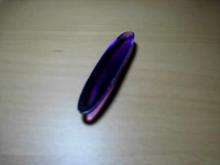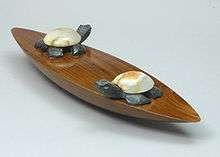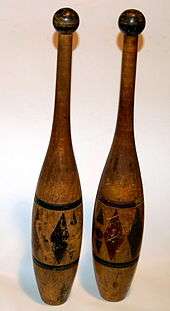Rattleback

A rattleback is a semi-ellipsoidal top which will rotate on its axis in a preferred direction. If spun in the opposite direction, it becomes unstable, "rattles" to a stop and reverses its spin to the preferred direction.
This spin-reversal appears to violate the law of the conservation of angular momentum. Moreover, for most rattlebacks the motion will happen when the rattleback is spun in one direction, but not when spun in the other. Some exceptional rattlebacks will reverse when spun in either direction.[1] This makes the rattleback a physical curiosity that has excited human imagination since prehistorical times.[2]
A rattleback may also be known as a "anagyre", "celt", "Celtic stone", "rebellious celt", "rattlerock", "spin bar", "Robinson Reverser", "wobble stone" (or "wobblestone") and by the product names "ARK", "Bizzaro Swirl", "RATTLEBACK", "Space Pet" and "Space Toy".
History
Archeologists who investigated ancient Celtic and Egyptian sites in the 19th century found celts which exhibited the spin-reversal motion. The antiquarian word "celt" (the "c" is pronounced as "s") describes adze-, axe-, chisel- and hoe-shaped lithic tools and weapons.
The first modern descriptions of these celts were published in the 1890s when Gilbert Walker wrote his "On a curious dynamical property of celts" for the Proceedings of the Cambridge Philosophical Society in Cambridge, England, and "On a dynamical top" for the Quarterly Journal of Pure and Applied Mathematics in Somerville, Mass.
Additional examinations of rattlebacks were published in 1909 and 1918, and by the 1950s and 1970s, several more examinations were made. But, the popular fascination with the objects has increased notably since the 1980s when no fewer than 28 examinations were published.
Size and materials

While rattleback artifacts are described as stone with various measurements, most which are sold currently as novelty puzzles and toys are described as plastic with measurements of 3.75 inches long x 0.75 inches wide x 0.4375 inches high. Carved wooden rattlebacks are described with a measurement of 5.5 to 6 inches in length. One plastic rattleback made and sold by Charles W. Sherburne is described as 12 inches in length. Glass rattlebacks, and those made of spoons , are described as being tested with unreported measurements. Larger rattlebacks, and those of other materials, are not yet reported.
Two rattleback design types exist. They have either an asymmetrical base with a skewed rolling axis, or a symmetrical base with offset weighting at the ends.
Physics
The spin-reversal motion follows from the growth of instabilities on the other rotation axes, that are rolling (on the main axis) and pitching (on the crosswise axis).[3]

When there is an asymmetry in the mass distribution with respect to the plane formed by the pitching and the vertical axes, a coupling of these two instabilities arises; one can imagine how the asymmetry in mass will deviate the rattleback when pitching, which will create some rolling.
The amplified mode will differ depending on the spin direction, which explains the rattleback's asymmetrical behavior. Depending on whether it is rather a pitching or rolling instability that dominates, the growth rate will be very high or quite low.
This explains why, due to friction, most rattlebacks appear to exhibit spin-reversal motion only when spun in the pitching-unstable direction, also known as the strong reversal direction. When the rattleback is spun in the "stable direction", also known as the weak reversal direction, friction and damping often slow the rattleback to a stop before the rolling instability has time to fully build. Some rattlebacks, however, exhibit "unstable behavior" when spun in either direction, and incur several successive spin reversals per spin.[4]
Other ways to add motion to a rattleback include tapping by pressing down momentarily on either of its ends, and rocking by pressing down repeatedly on either of its ends.
For a comprehensive analysis of rattleback's motion, see V.Ph. Zhuravlev and D.M. Klimov (2008).[5] The previous papers were based on simplified assumptions and limited to studying local instability of its steady-state oscillation.
Realistic mathematical modelling of a rattleback is presented by G. Kudra and J. Awrejcewicz (2015).[6] They focused on modelling of the contact forces and tested different versions of models of friction and rolling resistance, obtaining good agreement with the experimental results.
Numerical simulations predict that a rattleback situated on a harmonically oscillating base can exhibit rich bifurcation dynamics, including different types of periodic, quasi-periodic and chaotic motions.[7]
See also
References
- ↑ "Introduction to Hugh's Talk". Millennium Mathematics Project. University of Cambridge. Retrieved 2013-10-19.
- ↑ "celt, n.2". OED Online. September 2012. Oxford University Press. 1 October 2012 <http://www.oed.com/view/Entry/29533?isAdvanced=false&result=2&rskey=EPfrjA&>
- ↑ http://online.kitp.ucsb.edu/online/dynamo08/moffatt/
- ↑ The Smithsonian/NASA Astrophysics Data System
- ↑ V.Ph. Zhuravlev and D.M. Klimov, Global motion of the celt, Mechanics of Solids, 2008, Vol. 43, No. 3, pp. 320-327.
- ↑ G. Kudra, J. Awrejcewicz, Application and experimental validation of new computational models of friction forces and rolling resistance, Acta Mechanica, 2015 (DOI: 10.1007/s00707-015-1353-z).
- ↑ J. Awrejcewicz, G. Kudra, Mathematical modelling and simulation of the bifurcational wobblestone dynamics, Discontinuity, Nonlinearity and Complexity, 3(2), 2014, 123-132.
Further reading
- Blackowiak, A. Donald. The dynamics of the celt with second order averaging and computer algebra. Cornell University. Ithaca, N.Y. 1996.
- Blackowiak, A. Donald, H. Kaplan and Richard H. Rand. "The dynamics of the celt with second order averaging and computer algebra." Proceedings of the ASME Design Engineering Technical Conferences. Sacramento. 1997.
- Boardman, Allan J. "The mysterious celt." Fine Woodworking, 53:68-9. The Taunton Press Inc. Newtown, Conn. July/August 1985.
- Bondi, Hermann. "The rigid body dynamics of unidirectional spin." Proceedings of the Royal Society of London for the Improvement of Natural Knowledge, A405:265-74. London. 1986.
- Caughey, T.K. "A mathematical model of the rattleback." International Journal of Non-Linear Mechanics, 15:293-302. Orlando, Fla. 1980.
- Crabtree, Harold. An elementary treatment of the spinning tops and gyroscopic motion. pp. 7, 54, plate I. Longmans, Green & Co. London. 1909.
- Crane, H. Richard. "How things work: The rattleback revisited." The Physics Teacher, 29(5):278-9. American Association of Physics Teachers. College Park, Md. 1991.
- Dammermann, W. "Celtic wackelsteine." Physics In Our Time, 12:178-80. 1981.
- Edge, Ronald D. and Richard Lee Childers. "String and sticky tape experiments: Curious celts and riotous rattlebacks." The Physics Teacher, 37(2):80. American Association of Physics Teachers. College Park, Md. 1999.
- Franti,L. On the rotational dynamics of the Rattleback,Central European Journal of Physics, Volume 11 (2013), Issue 2, pp 162–172,arXiv:1202.6506
- Garcia, A. and M. Hubbard. "Spin reversal of the rattleback: Theory and experiment." Proceedings of the Royal Society of London for the Improvement of Natural Knowledge, A418:165-97. London. 1988.
- Gray, Andrew. Treatise of gyrostatics and rotational motion. Macmillan Publishers Ltd. London. 1918. pp. 364-365.
- Holzhey, C. and H. Puschmann. "The Celtic wackelstein: A remarkable gyroscope." Recent Science, 1(2):6-15. 1986.
- Kane, Thomas R. and David A. Levinson. "Realistic mathematical modeling of the rattleback." International Journal of Non-Linear Mechanics, 17:175-86. 1982.
- Lindberg, R.E. Jr. and R.W. Longman. "On the dynamic behavior of the wobblestone." Acta Mechanica, 49:81-94. 1983.
- Magnus, Karl. "The stability of rotations of a non-symmetrical body on a horizontal surface." Festschrift Szabo, 19-23, Berlin. 1971.
- Magnus, Kurt. "Zur theorie der Keltischen wackelsteine." Zeitschrift für Angewandte Mathematik und Mechanik, 54:54-5. 1974.
- Markeev, A.P. "On the dynamics of a solid on an absolutely rough plane." PMM U.S.S.R, 47:473-8. 1983.
- McGeer, Tad and Leigh Hunt Palmer "Wobbling, toppling and forces of contact." American Journal of Physics, 57:1089-98. American Association of Physics Teachers. College Park, Md. 1989.
- Moffatt, Henry Keith. "Talk for the 50th anniversary." Journal of Fluid Mechanics, Cambridge University Press. Cambridge, England. 2006.
- Pascal, M. "Asymptotic solution of the equations of motion for a Celtic stone." PMM U.S.S.R, 47:269-76. 1984.
- Pascal, M. "The use of the method of averaging to study non-linear oscillations of the Celtic stone." PMM U.S.S.R, 50:520-2. 1986.
- Rand, Richard H. Topics in nonlinear dynamics with computer algebra. Gordon and Breach. Langhorne, Penn. 1994.
- Rand, Richard H. and Dieter Armbruster. "Perturbation methods, bifurcation theory and computer algebra." Springer-Verlag. New York. 1987.
- Satterly, John. "Induced rocking." American Journal of Physics, 26:625-7. American Association of Physics Teachers. College Park, Md. 1958.
- Satterly, John. "Rocking experiment with two degrees of freedom." American Journal of Physics, 21:267-73. American Association of Physics Teachers. College Park, Md. 1953.
- Satterly, John. "Three interesting instances of rocking." American Journal of Physics, 23:14-26. American Association of Physics Teachers. College Park, Md. 1955.
- Satterly, John. "Vibrational dynamics with lenses, mirrors and prisms." American Journal of Physics, 23:562-81. American Association of Physics Teachers. College Park, Md. 1955.
- Sherburne, Charles W. "ARK: Scientific demonstration toy." U.S. Design 210,947. Filed: Nov. 12, 1995. Patented: May 7, 1968. San Pedro, Calif.
- Walgate, Robert. "Tops that like to spin one way." Nature, 323:204. Nature Publishing Group, London. 1986.
- Walker, Gilbert Thomas. "On a curious dynamical property of celts." Proceedings of the Cambridge Philosophical Society, 8:305-6. Cambridge, England. 1895.
- Walker, Gilbert Thomas. "On a dynamical top." Quarterly Journal of Pure and Applied Mathematics, 28:175-84. International Press. Somerville, Mass. 1896.
- Walker, Jearl. "The Amateur Scientist: The mysterious 'rattleback': A stone that spins in one direction and then reverses." Scientific American, 241:172-84. Scientific American Inc. New York. 1979.
- Walker, Jearl. "The Amateur Scientist: Rattlebacks and tippe tops; Roundabout: The physics of rotation in the everyday world." Scientific American, 33-8, 66. Scientific American Inc. New York. 1985.
- Walker, Jearl. "Puzzling gyroscopes." Spektrum der Wissenschaft, part 1, December, 109-13, 1979; part 2, May, 151-7, 1981.
- Wheeler, Nicholas A. Rattlebacks—How do they work? Reed College Department of Physics. Portland, Ore.
- Zhuravlev, V.Ph. and D.M. Klimov. "Global motion of the celt." Mechanics of Solids, 43(3):320-7. 2008.
External links
| Wikimedia Commons has media related to Celtic rattlebacks. |
- Bondi, Hermann. "The rigid body dynamics of unidirectional spin." Proceedings of the Royal Society of London for the Improvement of Natural Knowledge, vol. A405, pp. 265–74. 1986.
- Borisov, Aleksei V. Ivan S Mamaev Institute of Computer Science, Izhevsk, Russian Federation Strange attractors in rattleback dynamics
- Brown University: To demonstrate a puzzling mechanical device with unidirectional rotational behavior. physics demonstration.
- Brown University: Torque of the devil. physics demonstration.
- Doherty, Paul. Scientific Explorations. Spoon Rattleback. 2000.
- Flinn Scientific Inc. "Celt Spoon."
- Krasnoukhov, Vladimir and Anatoli Kalinin. Stubborn Turtles.
- Pippard, A.B. "How to make a celt or rattleback." European Journal of Physics, vol. 11, pp. 63–4. Institute of Physics. 1990.
- Sanderson, Jonathan. Activity of the Week: Rattleback.
- Simon Fraser University: Celt. physics demonstration. Burnaby, British Columbia, Canada.
- Simon Fraser University: Rattleback. Engineering Science 100 Tutorial Group Nu. Burnaby, British Columbia, Canada.
- Singmaster, David. Celts -- Rattlebacks. South Bank University. London. 2004.
- University of Cambridge Millennium Mathematics Project "Boomerangs and Gyroscopes."
